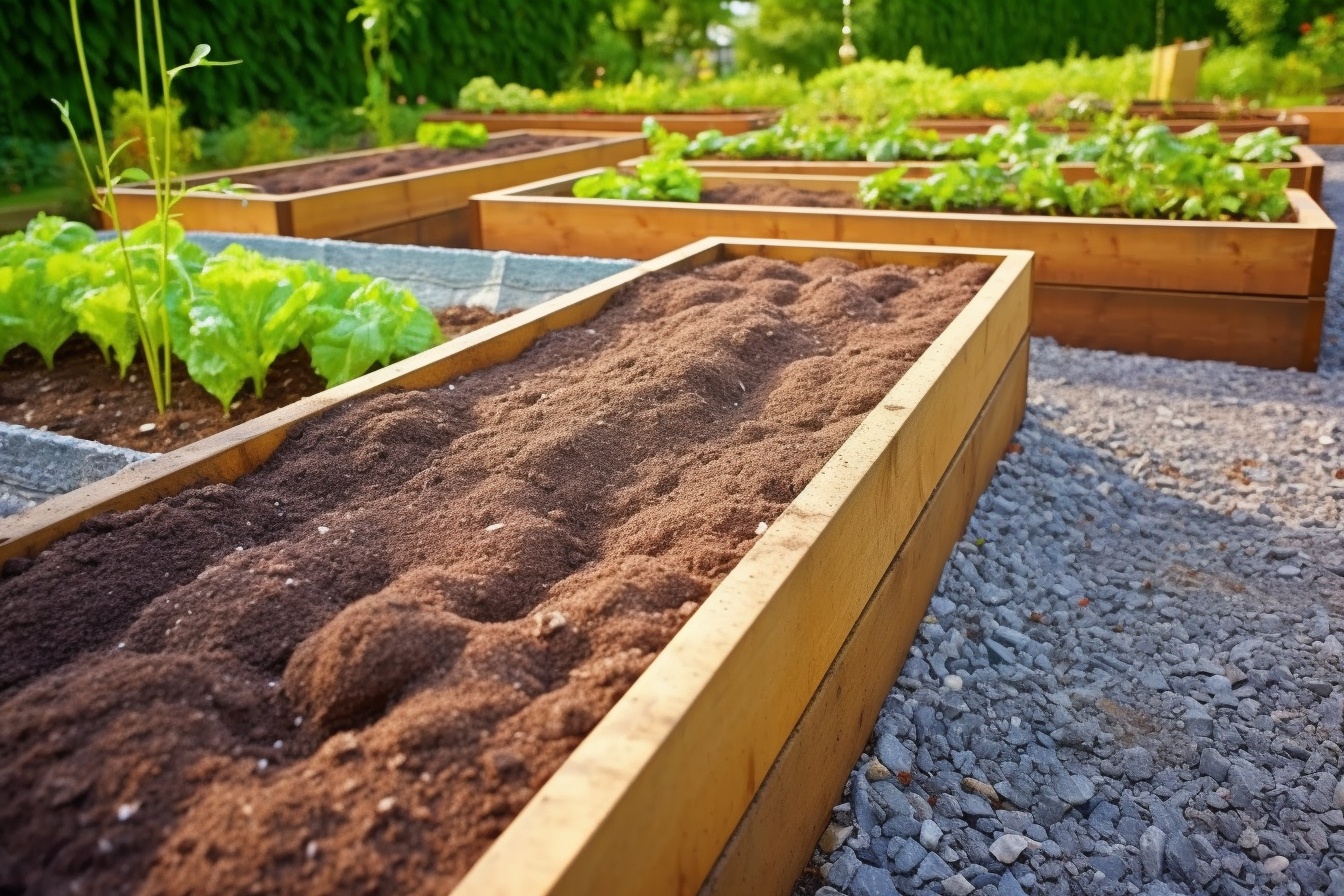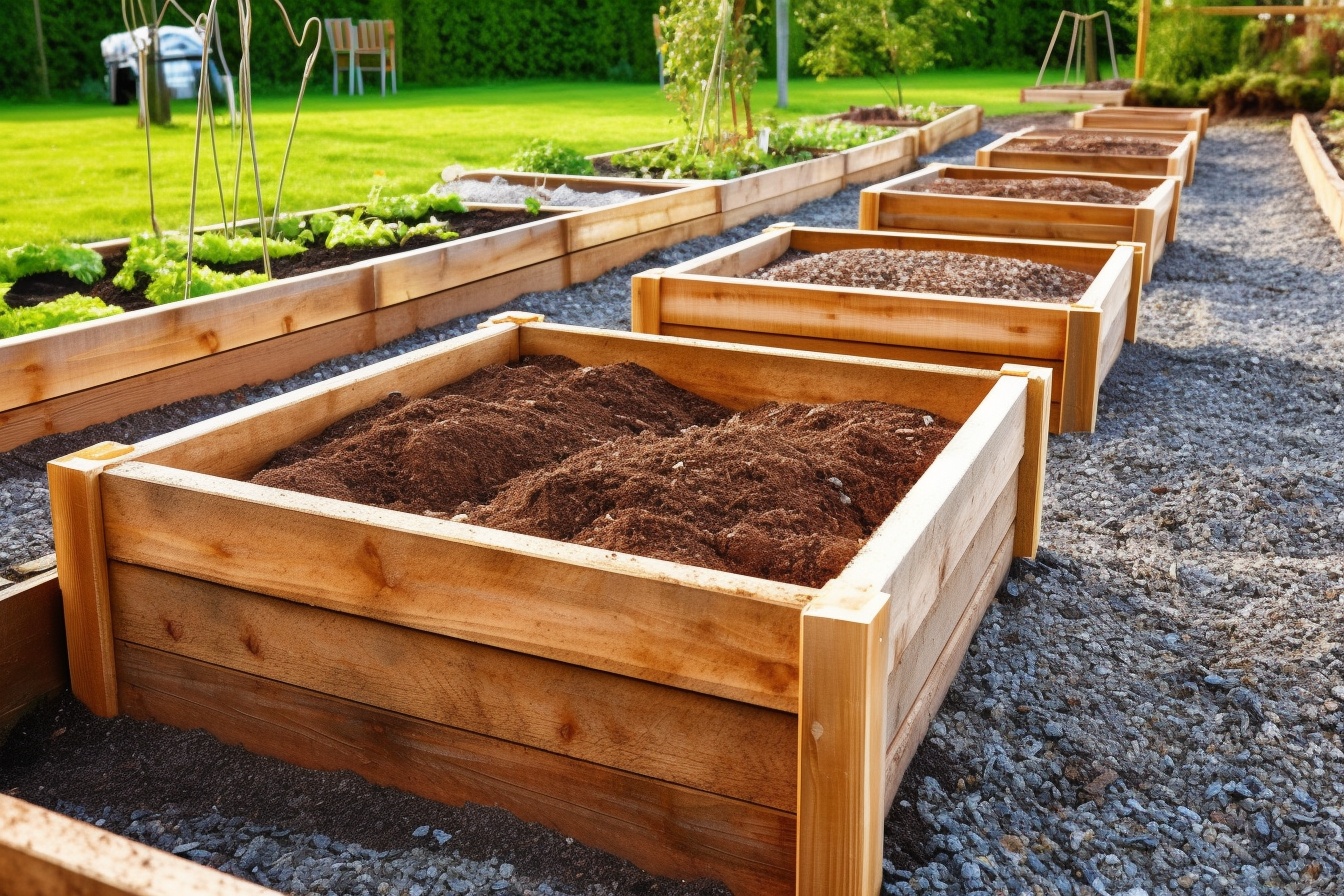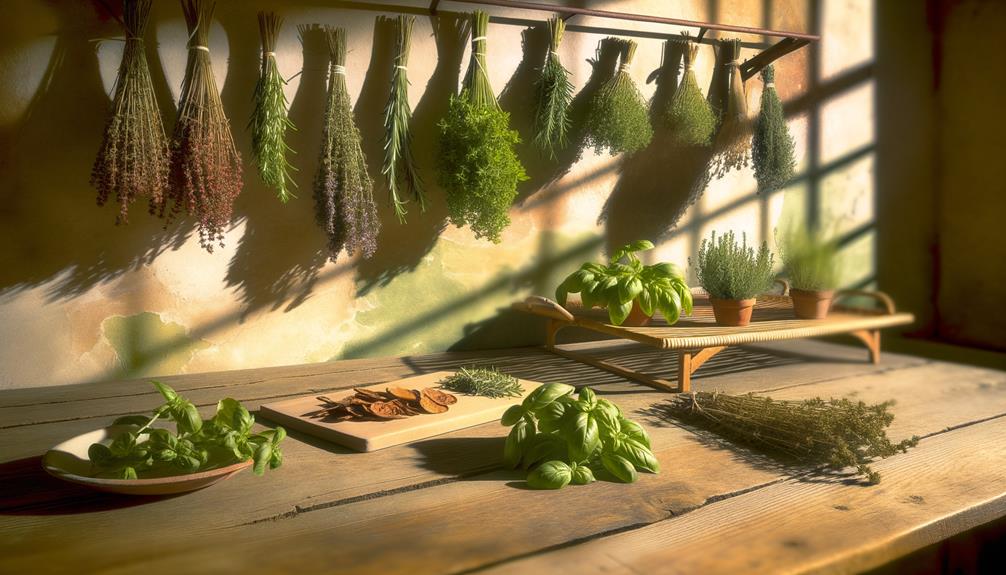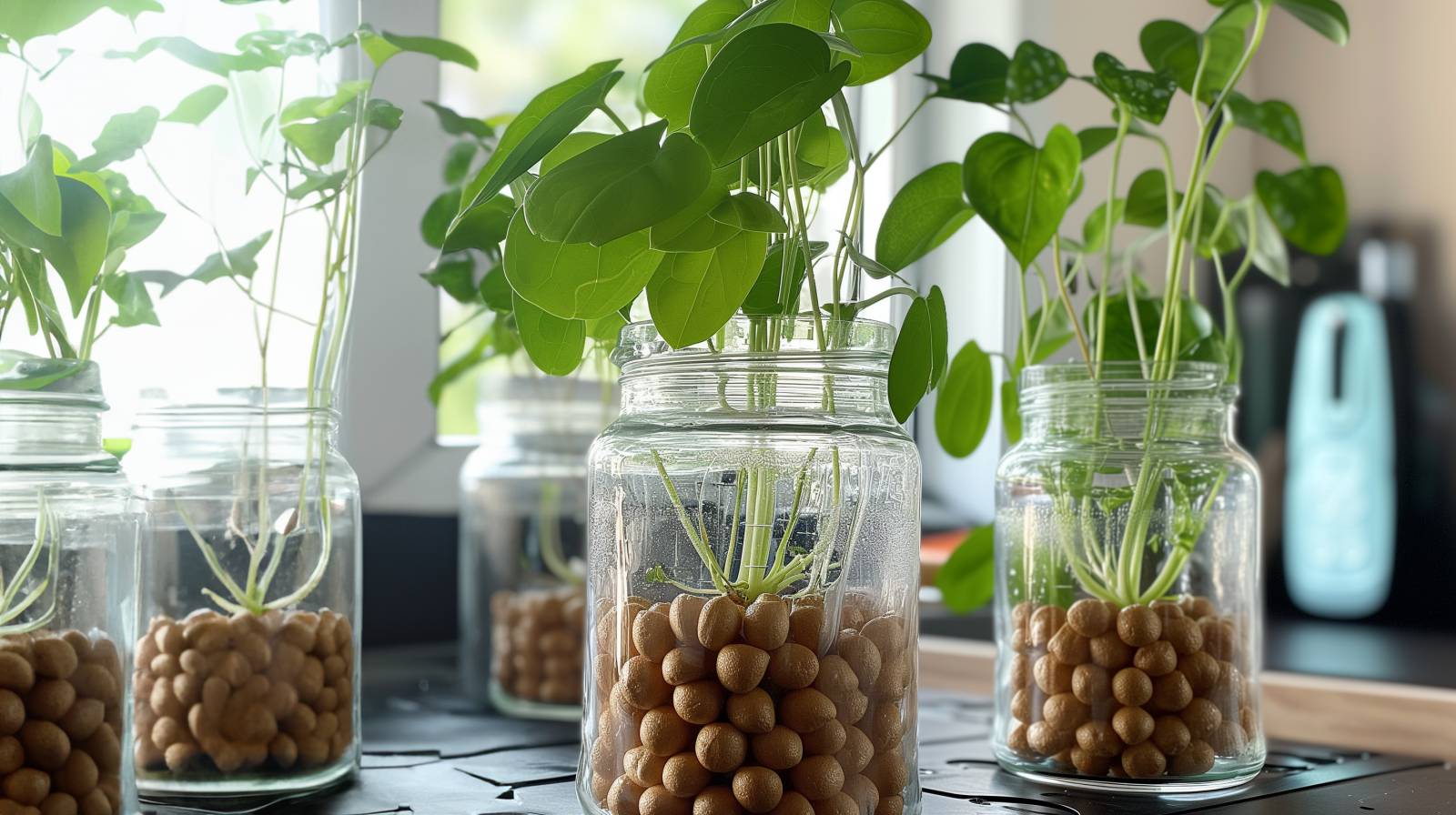What you put between raised garden beds to not only improves the appearance of your garden but also enhances its functionality. The space between the beds serves as an opportunity to add elements that can contribute to the health and productivity of your plants, as well as provide a comfortable space for you to work in. By selecting the right materials and design, you can elevate your garden’s aesthetic appeal, making it both visually pleasing and efficient.
Table of Contents
ToggleThere are various factors to consider when deciding what to put between your raised garden beds, such as drainage and weed control, maintenance requirements, and budget constraints. Each gardener’s preferences and priorities will guide their choice of material, whether it’s mulch, gravel, paving stones, or grass. These materials can have different benefits and drawbacks, so understanding your gardening goals is crucial in making the right selection.
As you explore different options, remember to prioritize your garden’s health, your personal style, and ease of maintenance, all while keeping in mind the unique environmental conditions in your region. By doing so, you’ll be able to create a garden space that thrives in both form and function, making it an inviting and fulfilling sanctuary for you and your plants.
Materials to Put Between Raised Garden Beds
Natural Materials
Wood: Cedar, pine, and other woods are suitable for creating a distinct border between your beds. Cedar is known for its natural rot resistance and can last for several years. Remember to choose untreated wood boards, as chemicals can leach into your soil, affecting your plants’ health.
Straw, Leaves, and Grass Clippings: These organic materials are ideal for adding a natural walkway between your beds. They can provide a comfortable, non-slip surface, improve soil quality, and reduce weed growth. It’s essential to replace straw, hay, and grass clippings periodically as they decompose over time.
Stones, Rocks, and Bricks: These materials not only enhance the aesthetic appeal of your garden but also help with drainage. When choosing stone or brick, opt for products that won’t disintegrate over time. Pea gravel, concrete blocks, and cinder blocks are solid options that require minimal maintenance.
Recycled Materials
Cardboard and Newspaper: If you’re looking for economical options, consider using cardboard and newspaper as weed barriers. When layered thickly, they are useful in preventing weeds from taking root. You may cover them with mulch or compost to hold them in place.
Pallets: Salvage wood pallets and repurpose them into lovely walkways between your garden beds. Ensure the wood is untreated and free of pests.
Burlap: Laying burlap scraps over cardboard adds a touch of warmth and keeps the paper intact. Additionally, burlap can slow down weed growth as it decomposes, making it budget-friendly and environmentally sound.
Synthetic Materials
Landscape Fabric: This product is specifically designed to block weeds. Installing a high-quality landscaping fabric between your beds allows air and water to pass while keeping weeds at bay. While it tends to be pricier than natural alternatives, it is low maintenance and long-lasting.
Plastic: A durable and cheap option, plastic sheets can provide a practical barrier against weed growth. Ensure that water drainage won’t be compromised, as excess moisture can damage your plants’ roots.
Metal: For a more permanent solution, metal sheets or panels are often used to separate garden beds. Metal is an investment upfront, but it will provide a visually appealing and maintenance-free border for many years.
Remember to consider the height, width, and overall layout of your garden when choosing materials, as they play a vital role in defining your garden’s look and accessibility.

Preparing the Area Between Raised Garden Beds
Removing Existing Growth
Before you start, remove any existing growth, such as weeds and unwanted plants, from the area between your raised garden beds. To do this effectively, use a hoe, hand fork, or a weeding tool to loosen the soil and uproot the unwanted growth. Dispose of the removed weeds and plants in a compost bin or a designated area to prevent them from re-establishing in your garden.
Adding the Chosen Material
After clearing the area, decide on the material you want to place between your raised garden beds. Some popular options include wood chips, gravel, and grass. Each material has its advantages and disadvantages, so choose the one that best suits your gardening needs and maintenance preferences.
- Wood chips: Wood chips can be a visually appealing choice that also helps retain moisture, suppress weeds, and decompose over time, adding beneficial nutrients to the soil. However, wood chips may need to be topped up periodically as they break down.
- Gravel: Gravel is a low-maintenance option that provides good drainage between your raised beds. It is less likely to attract pests, and it allows easy access to your garden beds. However, it doesn’t contribute to soil fertility, and it can be more difficult to remove if you decide to change the layout of your garden in the future.
- Grass: Planting grass between your raised garden beds creates a natural appearance and walking path. It can also help hold soil in place, reducing erosion. However, grass requires consistent mowing and may compete with your plants for sun, water, and nutrients.
No matter which material you decide on, be sure to apply it evenly between the raised beds, ensuring the spaces are level and secure. It’s essential to leave enough space between your beds for easy access and maintenance. Adequate spacing also reduces the risk of pests and diseases spreading between plants.
Maintaining the Space Between Raised Garden Beds
Weed Control
It is essential to keep the space between your raised garden beds weed-free to prevent competition with your plants for nutrients, water, and sunlight. You can effectively manage weed growth by:
- Applying a thick layer of mulch or wood chips on the ground between the beds.
- Using a landscape fabric or weed barrier to suppress the weeds from growing. Ensure to anchor it securely to prevent any wind displacement.
- Regularly pulling out weeds by hand or using a hoe to avoid using harmful chemicals in your garden that can affect the environment and your plants.
Water Management
Efficient water management in the space between raised garden beds is crucial for optimal plant growth and preventing excess moisture, which can attract pests and encourage weed growth. To ensure proper water management:
- Aim to water your plants early in the day to reduce evaporation and encourage efficient absorption of water.
- Install irrigation systems, such as drip lines or soaker hoses, to deliver water directly to your plants’ base and minimize water wastage between beds.
- Utilize tricks like rainwater harvesting to have a sustainable and cost-effective water source for your garden.
Pest Prevention
The space between your raised garden beds is an ideal location for pests to thrive if not properly maintained. To protect your plants from pests and diseases:
- Keep the area clean and free from debris and weeds that can harbor pests or diseases.
- Encourage beneficial insects, like ladybugs and lacewings, by incorporating plants that attract them, such as marigolds and dill.
- Utilize organic pest control methods, like diatomaceous earth, to deter pests without harming your plants or the environment.

Choosing the Right Raised Garden Bed Frame
When deciding on a raised garden bed frame, there’s a variety of materials you can choose from. Each material has pros and cons, so consider your needs and preferences before making your decision.
Wood is a common choice for raised garden bed frames due to its natural appearance and availability. However, be mindful that wood may rot over time, especially if exposed to moisture. Selecting rot-resistant wood types such as cedar, redwood, and cypress can extend the life of your raised bed.
Concrete offers durability and strength. It can be poured into any size or shape you desire for your raised garden beds. While this material can be more expensive and labor-intensive, a concrete raised bed will last for many years with minimal maintenance.
Plastic options, including reinforced composites, are lightweight, easy-to-assemble, and often more affordable than other materials. They tend to be less attractive than wood or concrete but are resistant to rot and insects.
Logs can be an inexpensive, rustic choice for your raised garden bed frame. However, logs decompose faster than traditional lumber, so this choice may require more frequent replacement.
Cinder blocks create a sturdy, low-cost raised bed that can be easily customized by altering the size and layout. The hollow centers of cinder blocks can even serve as additional planting space.
Metal raised garden bed frames, such as galvanized steel or aluminum, are strong, durable, and resistant to rot and pests. Metal options may be slightly more expensive but last longer than wood or plastic.
When it comes to the width of your raised bed, aim for a size that allows you to comfortably reach the center without having to step into the bed. A width of around three to four feet is typically optimal for most gardeners.









